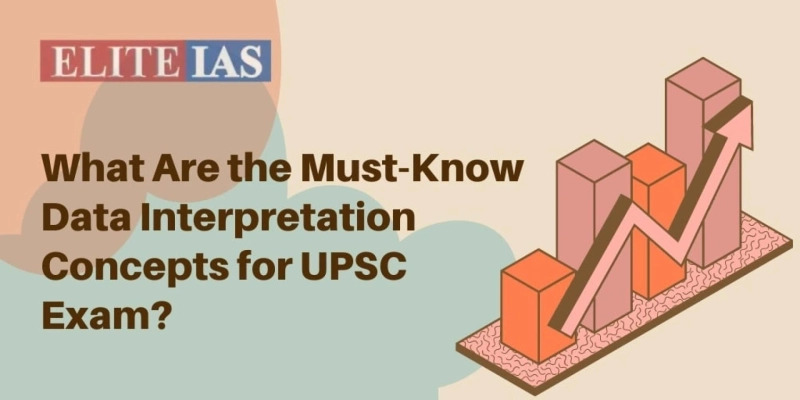Tables, graphs, charts - the data interpretation section throws a maze of mathematical data at UPSC aspirants. You sift through endless numbers, feeling more jumbled than enlightened. But what if you could slice through the confusion and pinpoint the core concepts that unlock maximum scores?
By identifying the must-know data interpretation frameworks, you can optimize preparation time. Learn how UPSC toppers tame volumes of data into accessible insights. Master the art of quickly extracting key information to solve problems logically.
In this article, we provide UPSC aspirants with a crisp guide to essential data interpretation concepts frequently tested in prelims and mains. Let\'s transform this challenging section from dreadful to favorable by honing the must-have analytical skills it demands. Numbers and logic need not be scary - embrace data interpretation as an opportunity to let your analytical thinking shine!
Understanding the Importance of Data Interpretation
Data interpretation is a skill that goes beyond simply reading numbers and figures. It involves the ability to extract meaningful insights and draw conclusions from complex data sets. In UPSC exams, this skill is highly valued as it assesses a candidate\'s analytical and problem-solving abilities, which are essential qualities for a civil servant.
The Types of Data in UPSC Exams
Before delving into the core concepts, it\'s crucial to understand the types of data you may encounter in UPSC exams. The data can generally be categorized into the following:
1. Numerical Data
Numerical data includes quantitative information presented in the form of numbers. It can be in the form of statistics, percentages, or numerical values. Aspirants must be proficient in performing calculations and analyzing numerical data accurately.
2. Graphical Data
Graphical data is often presented through charts, graphs, and diagrams. Candidates should be able to interpret these visual representations effectively. This involves understanding trends, patterns, and relationships between variables.
3. Textual Data
Textual data consists of written information, such as reports, articles, and case studies. Candidates must extract relevant information from textual data, summarize key points, and make informed decisions based on the provided content.
Key Data Interpretation Concepts
Now, let\'s explore the essential data interpretation concepts that can help you ace your UPSC exam:
1. Percentages and Ratios
Percentages and ratios are fundamental concepts in data interpretation. You\'ll often encounter questions that require you to calculate percentages or compare different ratios. A solid understanding of these concepts is vital for accurate data analysis.
2. Data Visualization
Data visualization involves interpreting data from graphs and charts. You should be proficient in reading and understanding various types of graphs, such as bar graphs, pie charts, and line graphs.
3. Data Inferences
Data inference is the ability to draw conclusions from data. You may need to make predictions, identify trends, or analyze cause-and-effect relationships based on the information provided.
4. Data Sufficiency
Data sufficiency questions test your ability to determine whether the given data is sufficient to answer a particular question. This concept requires a logical and systematic approach to problem-solving.
5. Case Studies
Case studies are a common format in UPSC exams. You must be able to extract relevant information, identify key issues, and propose solutions based on the information provided in the case study.
FAQs: Answering Your Data Interpretation Queries
Q1: Is data interpretation a significant part of the UPSC exam?
Ans: Yes, data interpretation is an integral part of various UPSC exams, especially the Preliminary Examination\'s aptitude paper.
Q2: How can I improve my data interpretation skills?
Ans: Practice is key. Solve a variety of data interpretation questions, review your mistakes, and seek guidance from experts or mentors.
Q3: Are there any recommended books or resources for data interpretation?
Ans: While there are several books available, you can start with NCERT textbooks for a strong foundation. Additionally, online resources and UPSC coaching materials are valuable.
Q4: Can I use a calculator during the UPSC exam for calculations?
Ans: No, calculators are not allowed in UPSC exams. You must perform the calculations manually.
Q5: What is the best approach to tackling data sufficiency questions?
Ans: First, carefully analyze the information provided and assess whether it\'s sufficient to answer the question. Then, approach the problem systematically, eliminating answer choices as needed.
Conclusion
In conclusion, mastering data interpretation concepts is crucial for success in UPSC exams. The ability to analyze numerical, graphical, and textual data is a skill that sets successful candidates apart. By understanding percentages, ratios, data visualization, data inferences, and data sufficiency, you\'ll be better equipped to tackle the challenging data interpretation questions that may appear on your UPSC exam. Remember, practice and continuous learning are the keys to excelling in this area. Good luck with your UPSC journey!
Want to master data interpretation and ace the UPSC exam? Enroll in the best UPSC coaching in Delhi today!
Master data interpretation concepts for UPSC with Elite IAS Academy - Delhi\'s best UPSC coaching institute! Get simplified teaching of ratios, graphs, inferences, and more from expert faculties. Visit Elite IAS Academy or call +91-7065202020 to join the top UPSC coaching in Delhi today!



